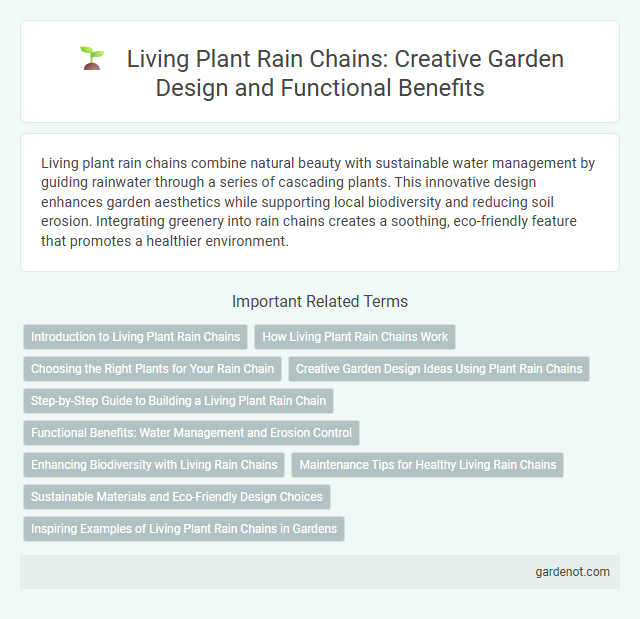Living plant rain chains combine natural beauty with sustainable water management by guiding rainwater through a series of cascading plants. This innovative design enhances garden aesthetics while supporting local biodiversity and reducing soil erosion. Integrating greenery into rain chains creates a soothing, eco-friendly feature that promotes a healthier environment.
Introduction to Living Plant Rain Chains
Living plant rain chains blend traditional rain chains with vibrant greenery, creating an eco-friendly water feature that enhances garden aesthetics and supports local ecosystems. These rain chains integrate trailing plants or succulents, allowing water to cascade gently while nourishing vegetation embedded along the chain. This sustainable design reduces soil erosion and improves water retention, making it an ideal choice for environmentally conscious landscaping.
How Living Plant Rain Chains Work
Living plant rain chains function by guiding rainwater down a series of interconnected planters or containers filled with live plants, which absorb and filter the water as it flows. This natural filtration process reduces runoff and enhances water retention, promoting healthier plants and preventing soil erosion. The integration of vegetation transforms the rain chain into a sustainable irrigation system that benefits both garden ecosystems and water conservation efforts.
Choosing the Right Plants for Your Rain Chain
Selecting the right plants for your living plant rain chain involves choosing species that thrive in moist environments and can handle occasional water flow. Mosses, ferns, and small succulents are ideal options due to their resilience and ability to retain moisture, enhancing both aesthetics and functionality. Incorporating native plants adapted to your local climate ensures durability and minimal maintenance for a sustainable rain chain garden feature.
Creative Garden Design Ideas Using Plant Rain Chains
Living plant rain chains transform ordinary water drainage into a vibrant vertical garden feature, seamlessly blending functionality with aesthetics. Integrating moss, succulents, or trailing vines into the links creates dynamic textures and enhances biodiversity in creative garden designs. These eco-friendly rain chains provide sustainable irrigation while adding a soothing water sound and visual appeal to outdoor living spaces.
Step-by-Step Guide to Building a Living Plant Rain Chain
Constructing a living plant rain chain begins with selecting drought-tolerant, cascading plants such as sedum, ivy, or moss that thrive in moist environments. Secure a sturdy rain chain frame or link connectors beneath the gutter downspout to support the weight of the plants and allow water flow. Plant each section carefully, ensuring roots have adequate soil or moss medium to retain moisture, creating an eco-friendly water feature that combines aesthetics with garden irrigation.
Functional Benefits: Water Management and Erosion Control
Living plant rain chains effectively manage water flow by guiding rainwater from gutters to the ground or drainage areas, reducing water runoff and preventing soil erosion. The integration of plants along the rain chain enhances water absorption, promoting groundwater recharge and stabilizing surrounding soil with root systems. This natural water management solution minimizes landscape damage while supporting sustainable outdoor environments.
Enhancing Biodiversity with Living Rain Chains
Living plant rain chains integrate lush greenery with traditional water flow systems, creating microhabitats that attract pollinators like bees and butterflies. These rain chains support local ecosystems by promoting native plant growth and providing shelter for small wildlife, enhancing urban biodiversity significantly. Utilizing living rain chains helps manage stormwater naturally while fostering a vibrant and sustainable environment.
Maintenance Tips for Healthy Living Rain Chains
To maintain a healthy living plant rain chain, regularly trim overgrown foliage to prevent blockages and promote airflow. Ensure the plants receive adequate water and nutrients by checking soil moisture and applying balanced fertilizer during the growing season. Inspect the structure for any damage or loose connections to support plant growth and rainwater flow effectively.
Sustainable Materials and Eco-Friendly Design Choices
Living plant rain chains combine sustainable materials like bamboo, recycled metal, and biodegradable fibers to minimize environmental impact while enhancing natural aesthetics. The integration of living plants aids in water filtration and supports local biodiversity, promoting an eco-friendly approach to rainwater management. These design choices contribute to reducing runoff pollution and encouraging sustainable gardening practices in urban and residential settings.
Inspiring Examples of Living Plant Rain Chains in Gardens
Living plant rain chains transform garden spaces by combining the soothing flow of water with lush greenery, creating a dynamic and eco-friendly water feature. Examples like trailing ivy draped along copper chains or succulents nestled in moss-filled cups illustrate how these rain chains enhance aesthetic appeal while supporting plant health. Their ability to guide rainwater gently through foliage reduces erosion and promotes natural irrigation, making them an inspiring choice for sustainable garden design.
Living plant rain chain Infographic

 gardenot.com
gardenot.com